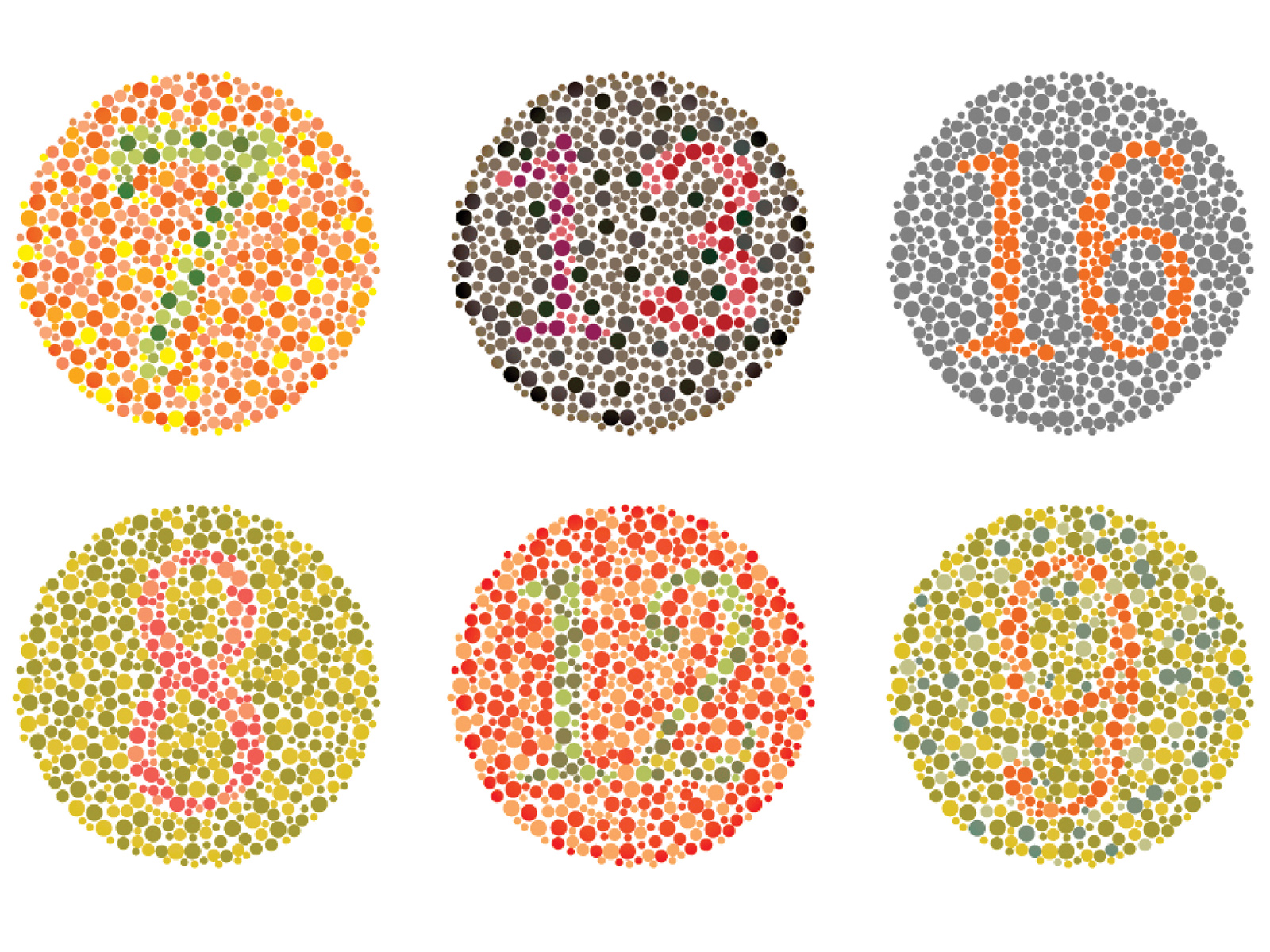The way we see and describe hues varies widely for many reasons: from our individual eye structure, to how our brain processes images, to what language we speak, or even if we live near a body of water.
By Nicola Jones
The way we see and describe hues varies widely for many reasons: from our individual eye structure, to how our brain processes images, to what language we speak, or even if we live near a body of water.
What colour is a tree, or the sky, or a sunset? At first glance, the answers seem obvious. But it turns out there is plenty of variation in how people see the world—both between individuals and between different cultural groups.
A lot of factors feed into how people perceive and talk about colour, from the biology of our eyes to how our brains process that information, to the words our languages use to talk about colour categories. There’s plenty of room for differences, all along the way.
For example, most people have three types of cones—light receptors in the eye that are optimized to detect different wavelengths or colours of light. But sometimes, a genetic variation can cause one type of cone to be different, or absent altogether, leading to altered colour vision. Some people are colour-blind. Others may have colour superpowers.
Our sex can also play a role in how we perceive colour, as well as our age and even the colour of our irises. Our perception can change depending on where we live, when we were born and what season it is.
To learn more, the author spoke with visual neuroscientist Jenny Bosten of the University of Sussex, who wrote about the topic in the 2022 Annual Review of Vision Science.
Q) How many colours are there in the rainbow?
Physically, the rainbow is a continuous spectrum. The wavelengths of light vary smoothly between two ends within the visible range. There are no lines, no sharp discontinuities. The human eye can discriminate far more than seven colours within that range. But in our culture, we would say that we see seven colour categories in the rainbow: red, orange, yellow, green, blue, indigo and violet. That’s historical and cultural.
Q) Is that what you taught your own kids, now aged 10 and 5?
I didn’t teach them anything about colour because I was interested in observing what they naturally thought about it. Like, for instance, my daughter, probably at the age of 5, said: “Are we going to the blue building?” To me, it looked white. But it was illuminated by a blue-sky light. There’s also an anecdote that I’ve heard—I don’t know if there’s any solid evidence for this—that children can sometimes initially call the sky white, and then later they learn to perceive it as blue.
There are several big datasets out there looking at colour categorization across cultures. And the consensus is that there are some commonalities. This implies that there might be some biological constraints on the way people learn to categorize colour. But not every culture has the same number of categories. So, there’s also this suggestion that colour categories are cultural, and cultures experience a kind of evolution in colour terms. A language might initially have two or three colour distinctions, then build in complexity over time.

In some languages, like old Welsh, there’s no distinction made between blue and green—they fall into a kind of “grue” category in others. In Russian, it’s siniy for dark blue and goluboy for lighter blue. Do speakers actually perceive colours differently? Or is it a linguistic thing? The jury’s still out on that.
Q) One common variation is red-green colour blindness. What causes that?
That would be an abnormality in either the L or the M cone types. In dichromacy—that’s the severe form of red-green colour vision deficiency—you’d be missing either the L or the M cones, or they’d be there but non-functional.
Red-green colour vision deficiency is also called Daltonism, after John Dalton, the English chemist from the 1790s. It wasn’t super obvious to him that his colour vision differed from the majority. But he noticed a few cases where his descriptions of colour differed from those of other people around him but were shared with his brother. He thought it was to do with an extra filter within the eye. But then, many years later, others were able to sequence his DNA and they could show that he was a dichromat.
In the mild form, anomalous trichromacy, you’d still have two different cone types, but they would just be much more similar to each other, in terms of the wavelengths of light that they are optimized to detect, than they are normally. So, the range of perceived differences between red and green would just be reduced. Most people have three types of cone photoreceptor cells in the eye, each most sensitive to a different wavelength or colour of light. Some people have defective or missing cones, while others effectively have four different types.
Q) What does the world look like to those who have the more severe case?
For a dichromat, they’re essentially missing a whole axis of colour vision, and their colour vision is then one-dimensional. In terms of how it looks, it’s quite hard to say because we don’t know what, subjectively, the two poles of that dimension are. What’s preserved is the axis between violets and lime green in a normal colour space. So that’s often how it’s portrayed. But really, it could be any two hues that are perceived. We just don’t really know.
There have been some cases where people have been dichromatic in one eye only. And then you can ask them to match the colour they see from the dichromatic eye to colours presented to the normal, trichromatic eye. And in those cases, sometimes they see more from the dichromatic eye than we expect. But we don’t know whether that’s typical of a regular dichromat who doesn’t have the trichromatic eye to help wire up their brain.
Q) Do these variations from the norm always make the world less rich in terms of colour? Or can some genetic variations actually enhance colour perception?
Anomalous trichromacy is an interesting case. For the most part, colour discrimination is reduced. But in particular cases, because their cones are sensitive at different wavelengths, they can actually discriminate certain colours that normal trichromats can’t. It’s a phenomenon called observer metamerism.
Then there’s tetrachromacy, where a person with two X chromosomes carries instructions for both an altered cone and a regular one, giving them four kinds of cones. We know that this definitely happens. But what we don’t know for sure is whether they can use that extra cone type to gain an extra dimension of colour vision, and to see colours that normal trichromats can’t see or can’t discriminate.
The strongest evidence comes from a test where observers had to make a mixture of red and green light match a yellow; some individuals couldn’t find any mixture that would match the yellow. They would actually need three colours to mix together to make a match, instead of two. It’s as if there are four primary colours for them, instead of the usual three. But it’s hard to prove how and why, or what exactly they see.
Q) Do people know they have colour super-vision?
The women that we recruited didn’t know their colour vision status. More than 50 percent of women have four cone types. But, usually, two of them are just very subtly different, so that may not be enough to generate tetrachromatic vision.
Your own subjective experience of colour is so private, it’s hard to know how your colour vision compares to the people around you. John Dalton was the first person to identify red-green colour blindness, in 1798—that’s really quite recent. He had a severe type. But even that wasn’t totally clear cut for him.
Q) Are there other biological differences, beyond genes, that affect colour vision?
Yes. The lens yellows with age, especially after the age of 40, and that reduces the amount of blue light that reaches the retina. There’s also the macular pigment, which also absorbs short, blue wavelengths of light. Different people have different thicknesses of that depending on what they eat. The more lutein and zeaxanthin you eat, substances that come from vegetables like leafy greens, the thicker the pigment. Iris colour also has a small correlation with colour discrimination: It could be a factor in determining your very precise experience of colour. Blue eyed people seem to do slightly better in tests of colour discrimination than brown eyed people.
Q) Is our colour perception also affected by the world around us? In other words, if I grow up in a green jungle, or a yellow desert, would I start to discriminate between more colours in those regions of the rainbow?
Yes, it can be. And that that’s quite a hot topic in colour science research at the moment. Whether there’s a separate word for green and blue seems to depend, in part, on a culture’s proximity to large bodies of water, for example. Again, that’s a linguistic thing—we don’t know whether that affects their actual perception.
There’s also a seasonal effect on perception of yellow. There was a study in York, which is quite gray and gloomy in the winter and nice and green in the summer, and they found that the wavelength that people perceived as pure yellow shifted with the season—only by a small amount, but still a measurable amount.
And there’s also been an effect observed from the season of your birth, especially if you were born in the Arctic Circle. That is probably to do with the colour of light that you’re exposed to during your visual development.
The effect of the environment can affect perception in two opposite ways though: Different environments can contribute to individual differences in perception, but a shared environment can also counteract biological differences to make people’s perceptions more similar.
Nicola Jones is a freelance science reporter and editor who lives in Pemberton, British Columbia and writes for Knowledgeable Magazine. This article was edited for length.














